NIHONBASHI BRIDGE
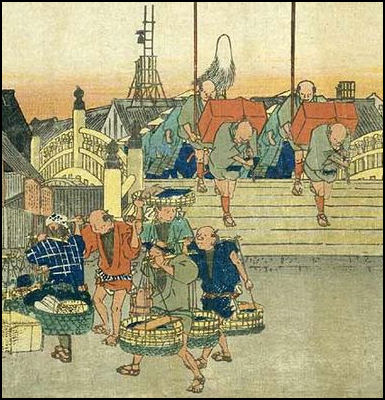
Hiroshige's 19th century Nihonbashi Nihonbashi Bridge (accessible from Nihonbashi station and Tokyo Station) has traditionally been the place designated as the center of Tokyo. Situated below the Tokyo Metropolitan Expressway, it is the zero marker for many long-distance roads that originate in Tokyo. Many businesses and financial institutions are located near it.
The first Nihonbashi bridge was built in 1603, right after the Tokugawa shogunate began. It became the starting point of five main highways from Edo (Tokyo) and was an important key spot for land and water transport for a variety of goods. A plate above Nihonbashi bridge contains an inscription that indicates that the starting point of national highways of Japan is inlaid on the roadway below. [Source: Yasuko Onda, Yomiuri Shimbun, August 17, 2014]
Nihonbashi Pier at the south end of Nihonbashi bridge opened in 2011, the 100th anniversary of the current bridge, which actually has 19 predecessors. A sightseeing boat trips that originates at the pier travels from the Nihonbashigawa river, which flows beneath the bridge, to the Sumidagawa river, before moving through the Onagigawa river to the Kitajikkengawa river, which flows past the base of Tokyo Skytree. The boat then retraces the route back to the starting point. The commercial facilities Coredo Muromachi 2 and Coredo Muromachi 3 opened in Nihonbashi district in 2014. Location: An about three-minute walk from the B12 exit of Nihonbashi Station, an about two-minute walk from the B6 exit of Mitsukoshimae Station, or an about eight-minute walk from the Nihonbashi exit of JR Tokyo Station will take you to Nihonbashi Pier.
Tokyo Station
Tokyo Station is the main long-distance train station. Located in the Marunouchi business district, it is the hub for most long distance rail service and shinkansen (bullet trains) to Kyoto, Osaka, Nagoya, Hiroshima and Kyushu in the south and Nagano, Yamagata, Niigata and Akita prefectures in the north. It is also the arrival point of long distance night buses from other cities in Japan. Tokyo Station has 28 platforms. Including the Shinkansen 3,900 trains with 900,000 passengers pass through the station every day.
Tokyo Station is a good starting point for sightseeing. Built in 1926, it is a mammoth five-story complex, housing department stores, restaurants and souvenir shops as well as ticket offices and train platforms. About 1.8 million people and 4,000 trains pass through Tokyo Station every day.

Japanese Royal family The two underground malls — Yaesu Chikagai and Tokyo Eki Meitengal — and Chu-dori Thoroughfare are good for shopping. The Western-style red-brick facade of the station facing the Marunouchi side is a traditional landmark, part of which is utilized as a hotel.
Restoration of the Marunouchi-side building to its original began in early 2006. Over a five year period the original design by architect Kingo Tatsuno (1854-1919), which includes a third floor and cupola domes destroyed in World War II, will be reconstructed. When the reconstruction is finished in 2011 the building will look it did in 1914.
Websites: JR East Tokyo Station Map jreast.co.jp ; Wikipedia Wikipedia ; Japan National Tourism Organization JNTO
Renovated Tokyo Station
JR Tokyo Station Marunouchi Building reopened in 2012 after an extensive renovation. After it reopened, the Yomiuri Shimbun reported: “JR Tokyo Station has now recovered its century-old appearance with the return of the curved ceilings of its domes and a third floor that was destroyed by U.S. bombing in 1945. The domed ceilings located at the north and south ends of the station building are the main feature of the newly restored facility. A luxurious relief inside depicting flowers and creatures of the Oriental zodiac make the building look just like it did in 1914 when it was completed. [Source: Koki Kataoka, Yomiuri Shimbun, October 2012]
“Through the windows of the hotel’s dome-side suites, guests can enjoy the decorative ceilings and gaze at passengers walking along the station floor below. At a restaurant on the second floor, patrons can enjoy the sight of trains running just beyond the window. The restaurant must be a gem for railway enthusiasts. Right next to the station’s North Exit stands Tokyo Station Gallery. Century-old original bricks and steel frames were used to build part of its interior. Some of its interior decorations include charred wooden bricks from the 1945 air raid, effectively turning the gallery into a work of art.
Tokyo Station Hote in the building, is performing well. Its occupancy rate in October is more than 70 percent and its restaurants are fully booked. With more people visiting the station, cash registers at nearby commercial facilities also have been ringing. "Reflecting the increase of tourists, sales have been even better at restaurants than in shops," said a public relations official at Mitsubishi Estate Co., which runs the two buildings. According to Hato Bus Co., which operates tour buses from near Tokyo Station, the number of customers who roll up and join a tour on that day is increasing. A Hato Bus official said many people go on a Tokyo sightseeing tour after visiting the station. Expectations are growing that the economic effects generated by the renovated station building will spread further. [Source: So Sasaki, Yomiuri Shimbun, October 24, 2012]
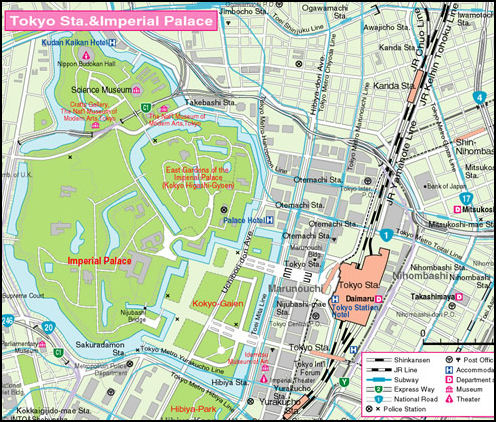
Marunouchi
Marunouchi (west side of Tokyo Station) is the largest office area and business hub in Japan. It is dotted with headquarters of leading banks and trading firms. The rows of glass and steel buildings here create a striking contrast to the nearby Imperial Palace. Many of the office towers have promenades running through them lined by fancy stores. The construction of replacements for old buildings is presently being promoted, and compound buildings with offices, shops and first-class hotels are going up one after another. Marunouchi Brick Square is a laid back place with an alfresco cafe and specialty shops overlooking a lush green square. The red brick building in the background is the Mitsubishi Ichigokan.
Lisa Vogt wrote in Asahi Weekly:“I work at the company headquarters in Marunouchi,” the woman sitting at the table next to mine proudly proclaimed to the group she was dining with. I think it was a “gokon” group blind date, and her statement immediately raised her status in the pecking order. People commented how “kakkoii” (prestigious and cool) that was. Through the ages some things do not change all that much. [Source: Lisa Vogt, Asahi Weekly, March 14, 2017 at 09:00 JST
“During the Edo Period (1603-1867), the Tokugawa Shogunate ruled Japan from Edo Castle. It was protected by extensive moats and gates and surrounded by residences. The word “maru,” meaning circle, was used when talking about castle grounds. The shogun lived in the safest inner citadel, the “honmaru,” and he was surrounded by secondary and tertiary citadels, “ninomaru” and “sannomaru,” which served as outer fortification. As you can guess, Marunouchi means inside the circle. The castle grounds were vast. Between the outer moat and inner moat was “daimyo koji,” the alley of feudal lords’ residences. Those here in Marunouchi were the privileged, the ones closest to the shogun. If “chonmage” guys and “nihongami” gals from Marunouchi had gokon back then, they’d have done pretty well!
“In the Meiji Era (1868-1912), the daimyo’s estates were confiscated by the new government. Part of Marunouchi became a training ground for the Imperial Japanese Army and a great chunk of land was purchased by what later would become the Mitsubishi Group. Tokyo Station was completed in 1914 and many Western-style buildings sprang up, giving the area the nickname London Block. Japan’s first office building, Mitsubishi Ichigokan, today houses a lovely museum with a charming little garden with excellent shopping and dining options. After World War II, buildings in Marunouchi were requisitioned by the General Headquarters of the Supreme Commander for the Allied Powers (GHQ/SCAP). DN Tower 21, previously known as the Dai-Ichi Life Insurance Company building, is famous for being the headquarters of GHQ but the famed MacArthur room is not usually open to the public.
“Meiji Seimei Kan on the other hand, the first National Important Cultural Property given to a structure built in the Showa Era (1926-89), welcomes visitors free of charge to tour the immaculately maintained building. Their excellent bilingual exhibition with interactive explanations is highly recommended. My hat’s off to them for this public service. Walking around, I noticed construction going on all around a small plot of greenery. The great lengths it obviously took to work around this tiny area seemed strange. It turned out to be the grave of Taira no Masakado, a samurai in the Heian Period (794-1185), who was beheaded in the year 940. If you were paying attention in Japanese history class, you’ll remember that legend has it that his head flew from Kyoto to Tokyo of its own accord. Otemachi, near Marunouchi, is where it ultimately landed.
“Evidently, whenever it is disrespected, bad things happen. Well, I guess it’s better to be safe than sorry, so after some risk analysis calculations, the decision was made to build around the site. I recently came across some 2016 figures that put the average cost of one square meter of land in Marunouchi at 17.73 million yen ($155,600).”
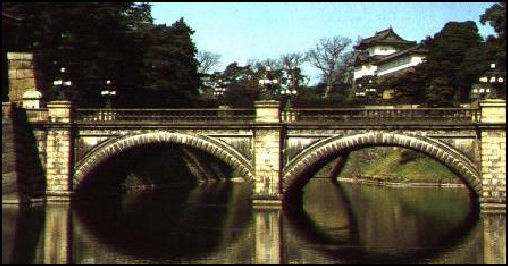
Imperial Palace
Imperial Palace (near Tokyo Station) is where the Emperor and the royal family resides. Surrounded by a moat patrolled by swans and traversed by a beautiful "double bridge," the palace is made up of many buildings that have been reconstructed several times. Handsome gates and old guard towers are set at intervals around the site. The current palace was built to replace the Meiji Palace, which burned down during a World War II air raid. It has a floor space of 23,000 square meters, was designed to avoid letting in much outside air as it was built during the years of high pollution.The broad green-roofed palace, where the royal family lives, is known as the Imperial Residence. It was completed in May 1993. It has an area of 4,940 square meters, and consists of areas for meeting guests, administrative work and private rooms.
Most of the palace is closed to the public on all but two days of the year (January 2nd and the Emperor's birthday on December 23rd). But visitors can still walk around the moats and some of the gardens and catch glimpses of some of the structures inside.
The 284-acre Imperial Palace grounds is covered mostly by lush forests and gardens. It occupies some of the world's most valuable real estate. At the height of the Bubble Economy in the 1980s, it was said this land worth more than the entire state of California.
The Imperial Palace grounds is divided into four main gardens: 1) the Outer Garden, which is open to the public; 2) the Fukiage Garden, where the Imperial Palace and the offices of the Imperial Household Agency are located; 3) the East Garden, home of many training centers for traditional crafts and occupations; and 4) the Kitanomaru National Garden.
These main gardens, for the most part are separated by moats and walls and of large boulders. A large moat also separates the Imperial Place grounds from central Tokyo. The Emperor has studied fish that live in the moats, which in fill with algae. An effort is being made to improve the circulation the moats to get ride of the algae. Beside some of the moats are busy roads. [Source: Robert Poole, National Geographic, January 2001] Websites: Wikipedia Wikipedia ; Imperial Household Agency sankan.kunaicho.go.jp ; Map sankan.kunaicho.go
History of the Imperial Palace:
The Imperial Palace was formerly known as Edo Castle. Built between 1603 and 1651, the original Edo castle was the home of the Tokugawa shogun and at one time was the largest castle in the world. Built "unparalleled under heaven," it and the Tokugawa dynasty were so formidable that the castle was never attacked. The massive boulders in the rough-hewn walls were brought in at considerable expense and effort from the provinces in the 1600s by the shogun’s overlords. This castle was destroyed in the Great Meireki Fire in January 1657.
In 1869, when the capital of Japan was moved from Kyoto to Tokyo, Edo castle became the home of the Emperor and was later renamed the Imperial Palace. The only surviving original structures are moats, walls made with huge stones and a few gates and guard towers which are set at intervals around the walls. In 1888 the palace was rebuilt. Most of these structures were destroyed by the Great Tokyo Earthquake of 1923 and by firebombing in World War II. The broad green-roofed palace, where the royal family lives, was completed in 1968.

Private Areas of the Imperial Palace
The green roof of the Emperor’s residence, the Main Gate (Seimon) and Nijubashi Bridge are visible from the Outer Garden. The extraordinary 350-tree Bonsai Garden is out of view behind the palace. It contains a 400-year-old "Crab Tree" and a 500-year-old juniper. An elite corp of Imperial Guards stand at attention at the gates, with batons and shields nearby which they never have had to use.
The gardens are quiet and peaceful. The East Garden in particular is designed as a place for quiet mediation and rejuvenation. It features well-tended paths lined with azaleas, zigzag bridges that confuse evil spirits and ponds full of koi fish. The dense beds of irises are laid out so the Courageous Lion and Monkey Dance don’t disrupt the Beast of Edo and the Wet Crow. Among the buildings in the East garden are the Archery Hall, the Kendo and Judo Hall, the Music Department, the Imperial Stables and the Imperial Guard House.
Fukiahe Garden is wild and unkept. Here you can find egrets searching for fish in the marshes and hawks hunting small birds. The Emperor likes to begin his day by taking a walk here. The gardens and ponds also provide a vital natural habitat and sanctuary for 65 species of bird. The birds that dominate the ground are large Jungle crows that act as if they own the place. Special filaments have been places above some of the gardens to keep them out.
In June 2008, the Japanese Emperor released an academic report with other researchers on the ecology of tanuki living on the grounds of the Imperial Palace. See Nature, Animals, tanukis
Public Areas of the Imperial Palace
The main entrance is approached by the elegant Nijubashi Bridge and is occasionally open to the public. Only a small part of the Imperial Palace it is open to the public. The Palace Plaza, the East Garden and Kitanomaru Park are the major areas of the Imperial Palace which are open to the public. The spacious plaza is an oasis for office workers and young couples at lunch time and in the evening. Thousands of joggers use the park areas around the Imperial Palace. So many use it in fact that showers have been set up for them and signs have been erected to urged them to considerate to people strolling around. Next to the moat is the much photographed view of Niju-bashi Bridge and the roof of the palace.

East Garden (part of the Imperial Palace) is open to the public from 9:30am to 3:30pm except Mondays and Fridays and entered at Otemon Gate, about a 10 minute walk north of Niju-bashi Bridge and a five minute walk from Otemmon station. The garden was once occupied by the main part of the castle. Covering 21 hectares, it embraces a dense forest, several historic buildings and a collections of trees with at least one representative from each of Japan’s 47 prefectures. You can walk around the entire garden in about an hour. Occasionally rat snakes are seen in the park.
Near Otemon Gate is a museum with 6,000 works form the Imperial collection, including paintings, crafts and documents. Ninomaru Park is famous for its pink azalea blossoms in May and irises in June. A stone marker marks the place where the famous Chushingura incident took place. This is when the daimyo named Asano, grazed the head of Kira Kozukenosuke, an the evil warlord and senior official in the Tokugawa shogunate, with his sword in a fit of anger in a corridor of Edo castle, setting of the series of events that launched the Tale of the 47 Loyal Assassins
Kitanomaru Park (part of the Imperial Palace) is a tidy, well laid out and unremarkable park. It contains the National Museum of Modern Art (mostly Japanese modern art), the Science Foundation Museum (Ueno's National Science Museum is better) and the Craft Museum. Nearby is Chidorigafuchi Park, noted for its cherry blossoms in the spring.
Hours Open: 9:00am-4:30pm (enter by 4:00pm March-April14 and September-October) or 5:00pm (enter by 4:30pm April15-August) or 4:00pm (enter by 3:30pm November-February) Closed: Monday, Friday, December23 and from December28-January3. It may close without notice in circumstances due to court functions or other occasions.
Yasukuni Shrine
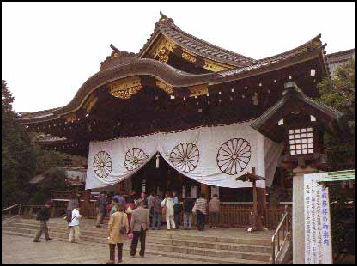
Yasukuni Shrine (near the Imperial Palace) is memorial whose purpose is to honor and deify hundreds of thousands who died in World War II and other conflicts in the late 19th and early 20th century. In some ways it the Japanese equivalent of Arlington National Cemetery except no one is buried there.
Founded in 1869 as a way of healing wounds of the Boshin Civil War and located on a hill overlooking the Emperor's Palace, Yasukuni Shrine is a simple Shinto-style building located the end of a 500-yard promenade in a 24 acre park. It is a weathered wooden shrine, like many in Japan, except for the strong presence of purple curtains bearing the chrysanthemum crest of the Emperor, flocks of specially-bred white doves that visitors can feed, a museum with controversial items and a Book of the Dead with some controversial names.
The shrine is not popular with Chinese and Koreans who say it glorifies participants in war crimes in their countries. Some Americans say it glories World War II war criminals. According to the BBC and Washington Post: “Yasukuni Shrine was built in 1869 under the Emperor Meiji. It memorializes almost 2.5 million Japanese, including women and children, who died in wars since 1868. The overwhelming majority — about 2.1 million — died in World War II. What makes the shrine so controversial is the fact that it honors hundreds of convicted war criminals, including 14 so-called Class A criminals, such as executed war-time leader Hideki Tojo, the prime minister who authorized the 1941 attack on Pearl Harbor. Their spirits have been "enshrined" there since 1960s and 70s. Shrine organizers stress that many thousands of civilians are honored. China and South Korea however see the shrine as glorification of Japanese atrocities. The 14 "Class A" war criminals were the men who ordered and oversaw Japan’s brutal war in China and South East Asia, which left millions dead and included widespread massacres of civilians, rape used routinely as a weapon and the use chemical and biological weapons by the Japanese against civilians.”
See Separate Article Yasukuni Shrine factsanddetails.com
Hibiya Area
Hibiya Park (next to the Imperial Palace Plaza) is a finely laid-out Japanese- and Western-style park. Floral attractions, particularly wisteria in May and chrysanthemums in November, draw a large number of visitors.
Hibiya City (near Hibiya Park) is fashioned after Rockefeller Center in New York. It is a business and office center with many shops and restaurants on the first floors and in the basements. Other attractions are showrooms of electronic gadgets and computers, and a courtyard that converts into a skating rink in the winter.
Hibiya Shopping and Amusement Quarter (between Hibiya Park and Yurakucho Station) is known as the "Broadway of Tokyo" because it is packed with cinemas and theaters.
National Diet Building
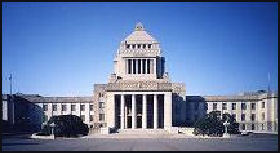
National Diet Building (Kokkai Gijido-mae subway station) is the home of the Japanese government. It is an imposing, white, three-story structure with a massive 200-foot-high, pyramid-topped tower. The right half of the building contains the House of Councilors (252 seats) and the left side contains the House of Representatives (480 seats).
The Diet building was erected in 1936. The mausoleum-like tower was reportedly inspired by Tomb of Halicarnassus, one of the Seven Wonders of the World. The building was built in part to honor Hirobumi Ito, "father" of the prewar constitution.
Tours of the Diet Building are popular, with almost a million visitors participating in them each year. According to the Yomiuri Shimbun: “One reason for this popularity may be that the tours are free. Applications to visit the House of Representatives or the House of Councillors are separately accepted by the secretariat of each house. The standard one-hour tour of the building includes a visit to the assembly hall of each chamber and a rest area for the Emperor. Tours of the Diet Building are sometimes included in school study tours and sightseeing tours in central Tokyo.” [Source: Yomiuri Shimbun, August 25, 2014]
Admission tickets are available to the Visitors Gallery. Most of the time there is little action: sleepy debates and speeches but occasionally there are aggressive pushing and shoving matches around the microphone. The Kasaumigaeski District, where the National Diet Building is located, is the political and administrative center of Japan. Websites: Wikipedia Wikipedia ; Japan Visitor Japan Visitor
Sengakuji Temple
Sengakuji Temple (near Senakuji subway station) is a modest temple dedicated to the 47 samurai who committed ritual suicide in 1702 to protest the unfair treatment of a feudal lord. Everyone in Japan knows the story. The 47 samurai are buried next to their lord. Their armor and possessions, including white-trimmed black ninja suits, are on display in a small museum (See History, Samurai, for the 47 Samurai story). Around the temple are samurai graveyards and other temples and shrines. Nearby, in the side streets off of Sakurada-dori, are traditional wooden houses that survived the firebombing during World War II. Website: Japan Guide japan-guide.com
GINZA
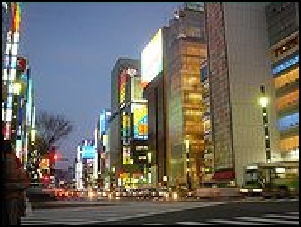
the area around
the Sony showroom GINZA (between the Imperial Palace and Tokyo Bay) is Tokyo's famous bright lights and big prices commercial and shopping area. The most well known spot in Tokyo, it is where you can find $150 cantaloupes, $3,000-a-night hotel suites, and $800 Italian shoes. It is best visited at night when it is lit up with "galaxies of neon advertisements." Among the most popular places are the Ginza Apple Store and Uniqlo’s flagship store.
Ginza is home to art galleries, and a plethora restaurants and boutiques. Every store its seems has a tradition and a culture unique to Ginza. Many of world famous brand boutiques have opened their shops in Ginza. There are large department stores such as Mitsukoshi, Matsuya and many large-size store buildings dotted around 4-chome in particular, where the street meets the intersection of Harumi-dori Avenue. Ginza means a silver mint, and its name derives from establishment of the silver coin mint in the 1600s.
Ginza is defined by Harumi, Chuo and Sotobori streets and covers an area that extends for about 600 meters from east to west and 1.1 kilometers from north to south. Closed to traffic every weekend between noon and 5:00pm, the main streets are lined with massive department stores, upscale boutiques, and fancy nightclubs. In the side streets around it are plush designer shops, art galleries, high tech showrooms and more than 1,000 restaurants.
There aren't many museums, shrines or temples or things of that nature in Ginza. The main landmark is semicircular Wako Cascade at Ginza 4-chrome. In recent years some of the luxury shops have folded and been replaced by American coffee shops and fast food chains, taking a little of the glamor away from the place, while new stores like Bulgari Ginza Tower and Chanel Ginza, designed by architect Peter Marino, have opened, bringing back some of the luster. Websites: Wikipedia Wikipedia ; Wikitravel Wikitravel ; Ginza Concierge ginza.jp ; Tokyo Essentials tokyoessentials.com ; Japan Guide www.japan-guide.com Ginza Map: Tokyo Pocket Guide tokyopocketguide.com
History of Ginza
Ginza has been an important commercial area since 1612 when a mint was built here. "Gin" means silver in Japanese and "Ginza" means shopping area. The district took the name Ginza in 1869. At one time there were 600 ginzas in Japan. Now there are about 30. Others have taken names like "plaza." In the Edo period, Ginza was famous for it artisans and made up mostly of wooden structures. After a fire in 1870 it was rebuilt with modern, brick buildings. In the rebuilding after the great earthquake of 1923 roads were widened and the area emerged as the major shopping and entertainment area of Tokyo. By the 1930s it was regarded as the trendiest area of Japan. After World War II t was rebuilt again.
Ginza was one of the first places in Tokyo to modernize. Some of Japan’s first Western-style buildings and it first department store were established here. The young men and women that gathered here in Western style clothes in the late 1800s and early 1900s were called “moga” (“modern girls”) and “mona” (“modern men”). When James Bond creator Ian Fleming visited Ginza in the 1960s he called it “one of the great pleasure streets of the world.” These days it is starting to loss some of its luster. In 2009 land prices dropped significantly in Ginza. Some designer names moved out because of low sales during the recession and high rents. Real estate companies were forced to drop prices to attract new tenants.
Shopping in Ginza
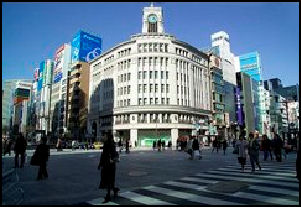
Ginza departmnet store Chuo-dori Street is the main thoroughfare of Ginza. The main Ginza shopping area is on Chuo-dori between Shinbashi and Nohonbashi. On weekends and national holidays when the main streets are closed to vehicles, it is transformed it into a wide pedestrian mall.
Ginza is home to six department stores and more than 30 foreign designer shops as well as many established shop over a hundred years old. Don't expect to find many bargains here. Even small shops have to pay hundreds of thousands, sometimes millions, of dollars for rent each year and these expenses naturally are passed on to the customers. Also don't expect to find many old traditional Japanese crafts. Most of items on sale in the Ginza are variations of the same high-tech or designer stuff available back home in America and Europe.
Many stores have neat gadgety stuff like high definition televisions that hang on walls like large paintings, cool digital audio equipment, and laser disc and computer technology that allows women to electronically "try on" hundreds different kinds of kimonos on a life-size projection screen.
Designer Shopping in Ginza
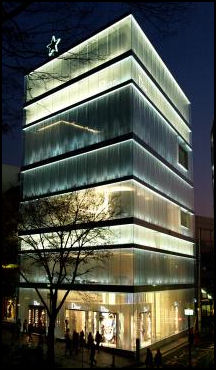
Dior building Among the well-known names found in Ginza are Christian Dior, Hermes, Cartier, Emilio Pucco, Coach, Dunhill, Tiffany’s and Gucci. A executive with Cartier told the Daily Yomiuri, “Ginza is where the most beautiful boutiques and brands are concentrated. They’ve gathered in a very limited area that is quite unique because you can walk for about a half an hour and you’ve got hundreds of brands with very nice, big stores.”
The Hermes store in Ginza was designed by Renzo Piano, the architect know best for designing the Pompidou Centre in Paris. Opened in 2001 with much fanfare, it is made of glass and brick and features hanging modern sculptures that resemble satellites, or at least it once did. In October 2004, the Dior store in Ginza opened a second floor store designed by Kimiko Inui that features a lattice of cane patterns lit by fiber optics at night.
The 10-story Chanel store, which opened in 2004, has a high-tech, diode-lit facade, representing quilting, designed by the architect Peter Marino. People waited in line all night when the store first opened to snatch up one-of-a-kind items. On top of the store is a restaurant run by the famous French chef Alain Ducasse.
Gucci opened an eight-story flagship store in November 2006. There is also a Tiffany’s, a Prada, a Pierre Marcolini, an expensive Belgian chocolate shop; Shieiso Parlor, where a Japanese cosmetics empire was launched; and Sayegusa, a 137-year-old children’s clothing store.
The Armani Ginza Tower is flagship store and mega boutique that opened in December 2007. Giorgio Armani himself was on hand for the opening in which Japanese formed a line around the block to buy handbags and other items. Armani has poured a lot of money into Japan. The Ginza store is one of the largest and most expensive Armani outlets ever built. It occupies an entire 12-story building with two basement floors and is organized like a department store with separate sections for clothing, food and housing items. Inside is Armani furniture, the world’s first Armani spa, an Italian restaurant and a member’s bar. Armani designed a special line of bags and clothes especially for the store.
The Italian designer Bulgari opened its largest flagship store in a 56-meter-tall Ginza building in December 2007. A rooftop terrace and garden are on the 11th floor. On the 19th floor is a restaurant with dinners that average between $150 and $200 per person. Cartier’s Ginza store is one of the most noticeable buildings in the district. Opened on November 2007 across the street from the Bulgari store, the nine-store golden building has chandelier on one floor and vintage watches displayed like museum pieces on another.
Ginza Six Shopping Complex
Ginza Six Shopping Complex opened in 2017 at the former site of the Matsuzakaya department store in Tokyo’s Ginza district. The 13-story complex hosts a total of 241 shops, including flagship outlets for international brands, high-end boutiques, a noh theater on a basement floor. The complex is partly owned by J. Front Retailing Co., which operates the Matsuzakaya department stores.. [Source: Kyodo, April 20, 2017]
After it opened Kyodo reported: “The exterior design of Ginza Six was inspired by traditional Japanese noren entrance curtains, while the interior is meant to offer a culture-rich experience with Japanese contemporary art and scenes of nature. Yachiyo Harada, a 68-year-old visitor said she was excited about the new venue in Ginza. “I’ve seen Ginza change rapidly. It’s sad to see the old scenery go, but with Ginza Six, the area will continue to evolve in a good way.”
“The rooftop provides a panoramic view of such landmarks as Tokyo Tower and Tokyo Skytree. “We hope that Ginza Six will become the core of not only Ginza but also Tokyo and the country,” Shingo Tsuji, president of Mori Building Co., one of the developers involved in the project, said at an opening ceremony this week.
“Ginza Six, so named because it is located in the sixth district of Ginza, has a total floor space of around 47,000 sq. meters, with six underground floors in addition to the 13 above-ground floors. Floors seven through 12 are set as office space. To accommodate foreign tourists, a terminal for tourist buses has been built within its premises and a tourist counter for currency exchange and duty exemption services is set up on the ground floor.”
Sony Showroom
As of 2016, the Sony Showroom occupies three floors of the relatively new Ginza Place complex. It features the company's cameras (4F), music and gaming gear, and other electronic products. A small art gallery on the sixth floor hosts photography exhibitions. Address : GINZA PLACE 4-6 floor, 5-8-1, Ginza, Chuo-ku, Tokyo 104-0061; Hours Open: 11:00am to 7:00pm
Sony Showroom has an interesting display of Sony's latest gizmos, gadgets and systems. It used to be housed inside Sony Plaza at Sukiyabashi Crossing in Ginza. That facility was comprised of eight floors, each with showroom focusing on a different product line. There, visitors could check out large screen entertainment centers, try on glasses that project videos in front of their eyes, play advanced PlayStation games, and check out a display of Aibos and other Sony robots.
Today's Sony Showroom is more like a store. Hitachi, NEC, Nissan and Toshiba used to have technology showrooms but they all have been closed. Panasonic has one. These days the Apple Store draws much bigger crowds.
Kabukiza Theater
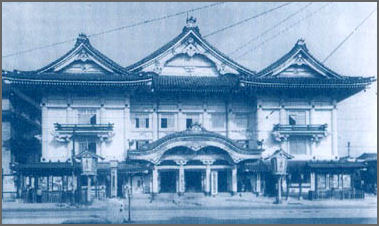
Kabukiza Kabukiza Theater (in Ginza, Subway: Hibiya Line or Asakusa Line, Higashi Ginza Station. Exit 3- ) is Japan's premier venue for kabuki. There are two box office beside the main theater entrance. The one on the right sells tickets for first, second and third floors and the boxes. The office on the left sells amphitheater (forth floor) tickets for ¥500 and ¥1,000. These are designed for people who want to watch only one scene and then leave, If you want to watch a entire performance you are better getting a third floor seat, which costs the same.
Although Japanese wear their best clothes, visitor's can wear what they like. People often eat noodles, curry, oden and bento meals during the performances. There are eight restaurants in the theater to serve customers. Ear phone guides are available in English for all performances on the first and third floor for ¥650 plus a ¥1,000 deposit. Leaflet guides in English are available for ¥1,000. C all ☎ (03)-3541-3131.
Kabuki-za kabuki theater was closed from April 2010 to April 2013 to undergo a transformation into a 150-meter-tall office building with theater. After it reopened after extensive rennovation, the Japan Times reported: “ The theater underwent its fifth makeover... It was first constructed in 1889 and was rebuilt due to a number of reasons, including fire and damage during World War II. The previous theater was built in 1951. The new Kabukiza, which has a normal seating capacity of about 1,900, features an upgraded audio system, including English translation, and stage equipment, as well as customer-friendly services such as barrier-free access and lavatories for disabled people. The theater will provide explanatory notes about the plays in Japanese on liquid crystal panels that can be taken to seats. A 29-floor office building is incorporated into the new complex. [Source: Japan Times, April 3, 2013]
See Separate Article Kabukiza Theater Under Entertainment in Tokyo factsanddetails.com
Image Sources: 1) Hiroshige 2) 4) Imperial Household Agency 3) 5) 8) 10) 11) Wikipedia 6) 7) twin isles 9) Sangin House of Councillors site 12) Ray Kinnane, 13) Kabuki 21 site
Text Sources: JNTO (Japan National Tourist Organization), Japan.org, Japan News, Japan Times, Yomiuri Shimbun, UNESCO, Lonely Planet guides, New York Times, Washington Post, Los Angeles Times, National Geographic, The New Yorker, Bloomberg, Reuters, Associated Press, AFP, Compton's Encyclopedia and various books and other publications.
Updated in July 2020
